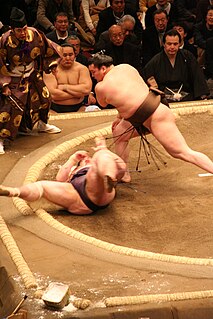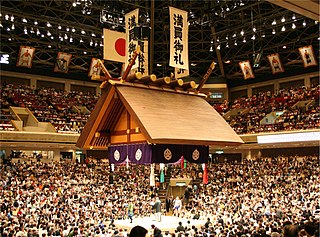
Sumo is a form of competitive full-contact wrestling where a rikishi (wrestler) attempts to force his opponent out of a circular ring (dohyō) or into touching the ground with any body part other than the soles of his feet.

A rikishi (力士), sumōtori or, more colloquially, osumōsan, is a professional sumo wrestler. Rikishi are expected to live according to centuries-old rules and, although there are some exceptions, most come from Japan, where sumo is practiced exclusively. Participation in official tournaments is the only means of marking achievement in sumo and the rank of an individual rikishi is based solely on official wins.

Makuuchi (幕内), or makunouchi (幕の内), is the top division of the six divisions of professional sumo. Its size is fixed at 42 wrestlers (rikishi), ordered into five ranks according to their ability as defined by their performance in previous tournaments.
The Japan Sumo Association is the body that operates and controls professional sumo wrestling in Japan under the jurisdiction of the Japanese Ministry of Education, Culture, Sports, Science and Technology (MEXT). Rikishi, gyōji (referees), tokoyama (hairdressers), and yobidashi (ushers/handymen), are all on the Association's payroll, but the organisation is run entirely by toshiyori (elders). The organization has its headquarters in Yokoami, Sumida, Tokyo.
Kinboshi is a notation used in professional sumo wrestling to record a lower-ranked (maegashira) wrestler's victory over a yokozuna.

A honbasho (本場所) is an official professional sumo tournament. There are six held each year, a system established in 1958. Only honbasho results matter in determining promotion and relegation for rikishi. Tournaments in general may be called basho.
Takeshi Inoue, known by his stage name Takeshi Rikiō, born December 20, 1972, is a Japanese retired professional wrestler, who worked for Pro Wrestling Noah. He is also a former sumo wrestler.
A toshiyori (年寄) is a sumo elder of the Japan Sumo Association (JSA). Also known as oyakata, former wrestlers who reached a sufficiently high rank are the only people eligible. The benefits are considerable, as only toshiyori are allowed to run and coach in sumo stables, known as heya, and they are also the only former wrestlers given retirement pay.

In sumo wrestling, a heya is an organization of sumo wrestlers where they train and live. It can also be termed sumo-beya. All wrestlers in professional sumo must belong to one. There are currently 45 heya, each of which belongs to one of five ichimon. They vary in size, with the largest heya having over thirty wrestlers and smallest just two. Most heya are based in and around the Ryōgoku district of Tokyo, sumo's traditional heartland, although the high price of land has led to some newer heya being built in other parts of Tokyo or its suburbs.
Professional sumo is divided into six ranked divisions. Wrestlers are promoted and demoted within and between these divisions based on the merit of their win/loss records in official tournaments. For more information see kachi-koshi and make-koshi. Wrestlers are also ranked within each division. The higher a wrestler's rank within a division is, the stronger the general level of opponents he will have to face becomes. According to tradition, each rank is further subdivided into East and West, with East being slightly more prestigious, and ranked slightly higher than its West counterpart. The divisions, ranked in order of hierarchy from highest to lowest, are as follows:

The following words are terms used in sumo wrestling in Japan.

A banzuke (番付), officially called banzuke-hyō (番付表) is a document listing the rankings of professional sumo wrestlers published before each official tournament or honbasho. The term can also refer to the rankings themselves. The document is normally released about two weeks before the tournament begins. On the banzuke wrestlers are divided into East, which is printed on the right, and West, which is printed on the left. Each wrestler's full shikona, hometown and rank is also listed. The top of the page starts with the highest ranked makuuchi wrestlers printed in the largest characters, down to the wrestlers in the lowest divisions which are written in much smaller characters. The names of gyōji, yobidashi (ushers/handymen), shimpan (judges), oyakata, and occasionally tokoyama (hairdressers) are also listed.

Yūshō is the term for a championship in Japanese. This article focuses on championships in the sport of professional sumo.
This page is based on this
Wikipedia article Text is available under the
CC BY-SA 4.0 license; additional terms may apply.
Images, videos and audio are available under their respective licenses.






